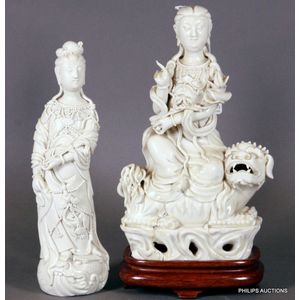Chinese Ivory Lady with Chrysanthemum and Bird
You must be a subscriber, and be logged in to view price and dealer details.
Subscribe Now to view actual auction price for this item
When you subscribe, you have the option of setting the currency in which to display prices to $Au, $US, $NZ or Stg.
- Ivory - Ivory is a hard white material that comes from the tusks of elephants, mammoth, walrus and boar, or from the teeth of hippopotamus and whales. The ivory from the African elephant is the most prized source of ivory. Although the mammoth is extinct, tusks are still being unearthed in Russia and offered for sale.
Ivory has been used since the earliest times as a material for sculpture of small items, both in Europe and the east, principally China and Japan.
In Asia ivory has been carved for netsuke, seals, okimono, card cases, fan supports, animals and other figures and even as carved tusks.
In the last 200 years in Europe ivory has been used to carve figures, for elaborate tankards, snuff boxes, cane handles, embroidery and sewing accessories, in jewellery and as inlay on furniture. Its more practical uses include being used for billiard balls, buttons, and a veneers on the top of piano keys.
The use and trade of elephant ivory have become controversial because they have contributed to Due to the decline in elephant populations because of the trade in ivory, the Asian elephant was placed on Appendix One of the Convention on International Trade in Endangered Species (CITES), in 1975, and in January 1990, the African elephant was similarly listed. Under Appendix One, international trade in Asian or African elephant ivory between member countries is forbidden. Unlike trade in elephant tusks, trade in mammoth tusks is legal.
Since the invention of plastics, there have been many attempts to create an artificial ivory - Rosewood - A dense timber that varies in shade to very light brown to almost black. When rosewood is cut and sanded the colour of the timber will turn black, and after polishing and exposure to daylight, the surface will gradually lighten over time to light brown with black streaks.
The name comes from the odour emanating from the timber when it is planed, sanded or cut.
Rosewood was very popular for use in Victorian furniture in the second half of the 19th century, and at that time most of the rosewood was imported from Brazil. However it also grows in India and Indonesia.
It is used in the sold for chairs and table legs, but for carcase furniture such as side cabinets and bookcases, and for table tops it is always used as a veneer.
This item has been included into following indexes:
Visually similar items

Two Dehua porcelain figures, qing Dynasty to Republic period, a heavily potted figure of Manjushri riding a lion, with various firing cracks, some losses, and with a double gourd stamp verso, with timber stand; and a slip moulded and modelled Guanyin figur

A Chinese ivory figure of Shoulao, late Qing Dynasty, holding a half eaten peach and looking curiously at a bat on his shoulder, a crane biting into a ruyi hanging from his arm, 23 cm high

A carved ivory figure of Kannon by Nobuyoshi, 19th century, standing on a rockwork base, wearing long layered robes with wide sleeves and a narrow celestial scarf rising above her shoulders, her hair drawn into a high chignon set at the front with an elabo

A large Dehua figure of Guanyin, early Qing Dynasty 17th/18th century, seated on a pierced rockwork platform, holding a ruyi sceptre, her hair tied in long strands, a square seal and a double-gourd seal impressed on the back. 36 cm high. Provenance: A Melb
